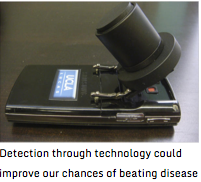
Prevention is better than cure, Desiderius Erasmus once said. While we continue to see the exciting development of more efficacious and tolerable treatments coming to market, a new form of prevention, or more precisely, detection, is growing quickly and it is fuelled by digital health.
Often, the survivability of terminal disease is enhanced greatly by early detection and treatment, as opposed to trying to cure the disease itself. But detection requires regular checks, and in the main, this means a trip to see your doctor. For many, this only happens when a symptom presents itself, and of course further specialist tests are needed before a solid diagnosis may be given.
However, today, as we walk around with smartphones, equipped with cameras, internet access and modest processing power, we may be carrying the future of diagnosis in our pockets. Technology in the form of apps for diagnosis, apart from being free and discreet to use, could be applied regularly by individuals whenever they felt the need. Imagine how early some diseases could be caught, potentially improving survival rates countless times over. This idea has not gone unnoticed in the technology community.
Indeed, evidence of the interest in this approach can be measured in the incredible venture capital investment into healthcare startups. Search for “health” on the TechCrunch website and there are news items on a daily basis discussing the latest Silicon Valley investments. The numbers are hardly modest either; seven figure dollar sums are being ploughed into these small enterprises.
Aside from the massive healthcare benefits, while clearly being the most important of all, there is also the financial improvement for government-provided healthcare and medical insurance providers. Tests and treatments cost money, especially over the lifetime of treatment patients can expect. Tackle a patient’s potential disease early through detection, and costs could plummet.
Outwardly, these digital investments – and their frequency – do feel a little like the dot com bubble in the nineties, but with the opportunity to improve healthcare outcomes from technology comes hope of a return. Indeed, there is a $10m reward for the first device to correctly diagnose up to 15 diseases in the human body. The rules are specific, with the device essentially requiring a size largely equivalent to a smartphone.
What’s interesting is that this new tech is another way in which digital media is enriching and evolving the healthcare landscape. For a while now, digital communications have been used to reach healthcare professionals and patients, while social media allows peer-to-peer connectivity, disease awareness and support. Now a new channel of opportunity and safety could be opening up.

